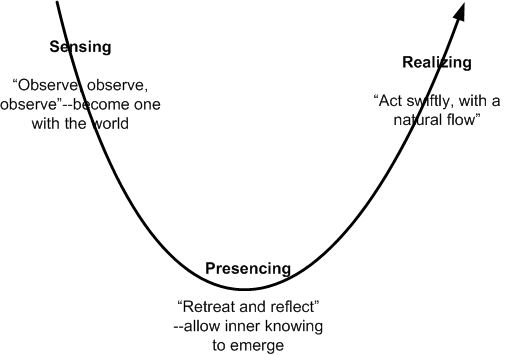Leadership is a complex topic. Get any number of leadership experts in the room and ask them to define leadership, and you’ll get something that sounds like the mumbling of the jury at a Perry Mason trial. (BTW, I understand those actors were saying, asynchronously, “watermelon watermelon watermelon.”) So, perhaps the best any budding or transitioning or growth-pursuing leader can do is to triangulate on what leadership is, and especially, on what leadership means to him or her. –All this does not mean you can’t hire someone to tell you, definitively, what leadership is: you definitely can do that.
Leadership occurs at many levels in organizations and in our own individual lives. The enacting of a decision to seek out a source of personal economic security (which for many of us is an income-generating job of some sort) and then attending to that source of economic security in a manner that assures its part in the fulfillment of our life goals is, arguably, an act of leadership. To attend to the job in a manner that assures the fulfillment of our goals includes things like showing up on time for those things that have time requirements and performing the role we have committed to in the organization according to our highest standards of conduct. This falls in the category of being “the hero of my own life,” as Dicken’s David Copperfield put it.
One of the most interesting writers on whole systems change and leadership I’ve read in the last several years is Otto Scharmer, specifically, his Theory U: Leading from the Future as it Emerges, subtitled The Social Technology of Presencing. One thing that all currently practicing leadership theorists may be able to agree on is that leadership is a social technology.
While Theory U is a rewarding, if perhaps demanding, and certainly well researched book, a key insight that I took away from it is that it is the leader’s job to help the system see itself. Specifically, “to enhance the individual and systemic capacity to see, to deeply attend to the reality that people face and enact. Thus the leader’s real work is to help people discover the power of seeing and seeing together” (p. 136). This requires strong observational (mindfulness) skills on the part of the leader as well as strong facilitative skills. Ultimately, the leader must “befriend” the human system s/he is attending to. A true friend will find a way to tell you when you’re functioning in a manner that is a disservice to yourself or counterproductive to your goals and values without alienating you. This is a coaching skill.
To help others with seeing, we need to be continually striving to assure clear vision on our own part. To listen to the human system in a way that you can even notice what’s going on with it, as opposed to what is going on with you as you listen to it, the leader must master herself, first and foremost. She must know herself, have herself in a proper perspective in relation to the human experience and to others, and it is likely she must be engaged in continuous self-improvement at a personal level—unless, of course, she is already in an enlightened or perfected state, which, I think most readers will agree, isn’t common.
While leadership has come to be considered a technical practice by many (do this to get this result; apply this protocol and people will beneficially respond this way) what really is proved out about leadership over time is that it is a practice which involves using the Self more than a set of protocols.
The work elaborated in Scharmer’s Theory U was actually first glimpsed in Presence: An Exploration of Profound Change in People, Organizations, and Society which was also published with the subtitle Human Purpose and the Field of the Future. Presence is the documentation of a series of conversations between Peter Senge, Otto Scharmer, Joseph Jaworski, and Betty Sue Flowers—each well recognized in his or her own professional field of inquiry and practice. During the course of these conversations, these four people noticed a common pattern of change and influencing of change that they initially called “Theory U”.

This “noticing” was a product of who each of them were, what skills and worldviews they held, and what eyes, ears, and intelligences they brought to the experience of their environments. Together, they noticed a pattern of change which they called “Theory U,” and Scharmer went on to elaborate it extensively and helpfully in his book. Many of the experiential accounts in Presence typify a facilitative style I find both interesting and useful, though it can be personally challenging.
There are many approaches to large group and interpersonal facilitation. Interpersonal facilitation would include such practices as coaching and mentoring, among others. I tend to class all these approaches into two categories: That form of facilitation in which the facilitator acts upon the other and that form of facilitation in which the facilitator is acted through and potentially (likely) changed by the act of the facilitation itself.
Most forms of facilitation seem to be in the former category; facilitators have tremendous power in this role. The very act of stepping to a white board and picking up a marker in front of a group is a very powerful act: only the notes the facilitator deems worthy of recording are represented before the group. To my mind, though all the facilitative techniques taught in the former category of facilitation are interesting and useful tools, it is the latter category that is the most interesting, and frankly, I believe it is the kind necessary in order for the leader to befriend the system and help the system “see itself” and as well as to help the people comprising the system to improve their skills at “seeing together.”
This is a very demanding form of leadership on almost every level. It requires the facilitative leader to be constantly in a willing state of transformation and to be observing herself in that state of transformation. In other words, not only is the leader constantly learning, but she is constantly growing as a result of her work as a leader, taking in information from her environment as part of her process of learning about herself and the world—as well as taking classes and trainings and reading and engaging in dialogue with respected colleagues. It is also the kind of leadership we seem to need today—and the kind that seems to be trying to emerge in so many ways.
Formerly, leaders were essentially seen as “fire bringers,” people who had traversed the hero’s journey in one way or another—through education, experience, or a combination of the two—or people who had particular might through physical prowess or financial means gained in any of a number of ways. Now it seems that the definition of the hero may be changing from “fire bringer” to “uniter,” though heroes and leaders have united diverse groups throughout time, not uncommonly at the point of the sword. While people seek leadership, as is clear when we tune our ear to the many complaints about lack of leadership in organizations and society together, when people give up leadership (sovereignty) over their own lives and cede responsibility for leadership decisions to others, they also lose personal agency as part of that transaction. Many people, especially knowledge workers, don’t like the outcomes that attend that transaction. They get querulous (for good reason) and critique their leaders for lack of appropriate leadership—among other things.
It is not shocking that self-designated followers, having sold or given away a portion of their personal agency, should be disappointed in the failings of their leaders. Having absolved themselves of the responsibility to make good decisions in a timely manner and invested others with not only the responsibility but the perhaps fictitious capacity to do so, these followers have also absolved themselves of the culpability that goes with a misstep. Like the Monday morning quarterback who could have run the play better if only he’d been on the field, they can commiserate with those outside “the leadership” who, had they been included, would have had the right answer to the problem before the group.
A wise young supervisor I worked with on a leadership team I was coaching often turned to an apt analogy. He realized that those who reported to him seemed to believe that, upon his promotion, he was given the Book of Answers by his supervisor. He realized he had no such book.
It seems that the further away from the work of individual contribution that the leader gets, the more important setting and optimizing vision and context is. The skill of facilitating the organization or work group’s best ability to “see itself” rather than simply handing it a flaming torch marked “the answer” is more critical as the work and the world (or market) become more complex. To stay useful as this lens through which the organization is enabled to see itself, the leader’s constant work on herself—her Self—is the essence of her professional development. The act of setting context and assuring clear vision has more to do with self-mastery and self-awareness than it does with manipulating others.
And perhaps this is why leadership training, when presented as a set of protocols, sounds like “watermelon watermelon watermelon” when leaders try to apply it as well as why leadership development is a lifetime process.






